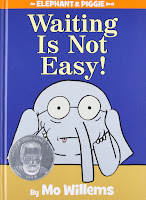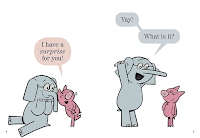 As an occupational therapist, a pretty common goal among many of the children I work with is helping them improve their ability to regulate themselves or be in better control of their bodies. Our focus the last few weeks at The Meeting House has been self-control. For those of you who aren’t familiar with the term, self-control is the ability to control one’s feelings or behaviors, particularly when in situations that may be difficult for them.
As an occupational therapist, a pretty common goal among many of the children I work with is helping them improve their ability to regulate themselves or be in better control of their bodies. Our focus the last few weeks at The Meeting House has been self-control. For those of you who aren’t familiar with the term, self-control is the ability to control one’s feelings or behaviors, particularly when in situations that may be difficult for them.
There are a ton of great children’s books that deal with this particular subject in a fun manner. Not only do they help children gain a better understanding of self-control but also provide some great strategies for those difficult times when they are having a hard time controlling their feelings or behaviors. There are many ways difficulty with self-control can come across in children. One of the most common things, especially in younger children, that they struggle with is waiting. Kids have to do a lot of waiting. Waiting for their turn, waiting in line, waiting for something they really want. They have to wait for things at home, in school and even at after-school programs and at the playground. Waiting is an unavoidable part of everyone’s lives but for kids who have sensory processing difficulties, it is especially difficult for them. You know that kid: the one who shouts out an answer without raising their hands, the one who pushes to the front of the line or insists on being first when playing a game. They are not trying to be “bad” so it’s important for them to learn about the importance of waiting and even develop some strategies to help them through those tricky times.
 This week I chose Waiting Is Not Easy by Mo Willems to help children learn about waiting. I have been a huge fan of the Mo Willems’ Piggie and Elephant series for a long time and love how they can help teach children about life lessons that so many struggle with. In Waiting Is Not Easy, Gerald has to practice patience after Piggie tells him he has a surprise for him. Gerald is not happy that he actually has to wait and wants it right away. He asks questions throughout the day and grows increasingly frustrated that Piggie won’t tell him what the surprise is. At the end of the day when he finally gets his surprise, Gerald realizes that the wait was definitely worth the wait!
This week I chose Waiting Is Not Easy by Mo Willems to help children learn about waiting. I have been a huge fan of the Mo Willems’ Piggie and Elephant series for a long time and love how they can help teach children about life lessons that so many struggle with. In Waiting Is Not Easy, Gerald has to practice patience after Piggie tells him he has a surprise for him. Gerald is not happy that he actually has to wait and wants it right away. He asks questions throughout the day and grows increasingly frustrated that Piggie won’t tell him what the surprise is. At the end of the day when he finally gets his surprise, Gerald realizes that the wait was definitely worth the wait!
Below, you will find some questions you can ask your children and activities that you can do with them after reading Waiting Is Not Easy:
~ask your children about times that it has been difficult for them to wait. Talk about how they feel when they have to wait.
~brainstorm strategies when they have to wait for something. Some of the things I have taught kids is to take a deep breath, count backwards from 10 or sing some song.
~play games with your children. This is a great way to practice waiting and turn taking with young children. Make sure that they your child isn’t always going first! Some of my favorite children’s games are:
*Yeti In My Spaghetti
*Pop The Pig
*Jenga
*The Sneaky, Snacky Squirrel Game
*Tumbling Monkeys
~there are a lot of great gross motor games that work on self-control, regulation skills and waiting! Here are a few of my favorite that you can play after reading Waiting Is Not Easy:
*Simon Says-children have to perform an action only when the leader says “Simon Says….”. For example, if the leader says, “Simon says touch your toes”, they should perform the action. If the leader says “Touch your toes”, they should stay as is.
*Freeze Dance-blast music and have the kids dance (remind them to be aware of their friends and not run into their bodies!). When the music stops, they have to freeze. For an added challenge, I sometimes have the kids perform an action when they freeze (freeze in a big shape, freeze as an animal, etc.).  *Red Light, Green Light-like vehicles, kids move on the green light and freeze on the red light. Sometimes I will have a visual cue to help the kids at first. For example, I will hold a red ball when I shout “red light” and a green ball when I shout “green light”. As they become comfortable with the game, I remove the visual prompts and have them rely on the verbal prompt. S
*Red Light, Green Light-like vehicles, kids move on the green light and freeze on the red light. Sometimes I will have a visual cue to help the kids at first. For example, I will hold a red ball when I shout “red light” and a green ball when I shout “green light”. As they become comfortable with the game, I remove the visual prompts and have them rely on the verbal prompt. S
*Ready, Set, Wiggle-the leader calls out Ready, Set, Wiggle and everyone has to wiggle their bodies. When the leader calls out Ready, Set, Watermelon, nobody moves. When they call out Ready, Set, Wigs, nobody moves. If you want to switch out different “W” words, you can. The point of the game is that the kids wait until they hear the word wiggle.
One of the most important ways to teach our children about self-control during waiting is to model it ourselves. We need kids to see that we can be patient and wait for things ourselves. If we model this behavior to our kids, they are more likely to be able to follow our lead.
I have a handful of other book recommendations that help children learn about self-control and waiting in a fun and kid-friendly way which I’m happy to share those with you. I’m always a click away and love hearing from you all.
